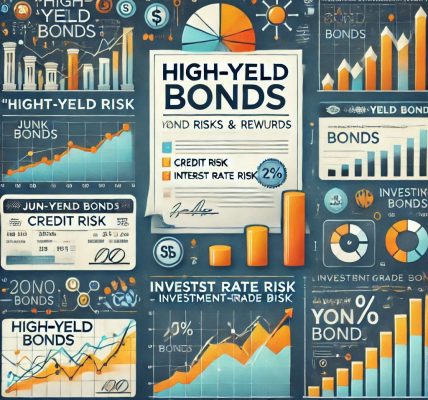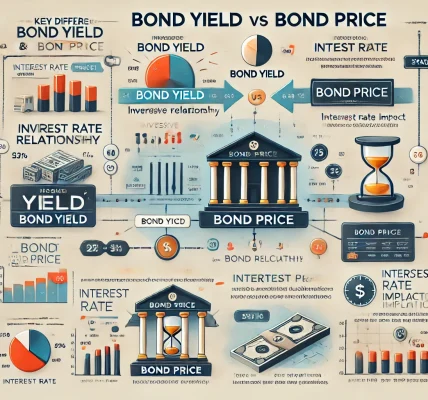Investing in bonds is a popular strategy for generating stable income and diversifying your portfolio. However, one of the most significant factors that affect bond prices and returns is interest rates. When interest rates rise, they can have a major impact on bond prices, which in turn affects investors’ portfolios.
In this blog, we will explore how rising interest rates influence bond prices, why this happens, and how investors can navigate this market environment to protect or enhance their returns.
Understanding the Relationship Between Bond Prices and Interest Rates
To fully comprehend how rising interest rates affect bonds, it’s essential to understand the basic relationship between the two.
- Bond Prices and Interest Rates are Inversely Related: When interest rates rise, the price of existing bonds falls, and when interest rates fall, the price of existing bonds rises. This inverse relationship is due to the fact that bonds pay a fixed coupon (interest) rate to investors. When new bonds are issued with higher interest rates, older bonds with lower rates become less attractive, causing their prices to drop.
- Why Does This Happen? Suppose you hold a bond that pays a 3% annual coupon. If interest rates rise to 4%, new bonds are being issued with higher yields, making your 3% bond less attractive. To sell your bond in the market, you would have to lower its price so that the yield it offers matches the new higher rates.
How Rising Interest Rates Affect Bond Prices
Rising interest rates can have several impacts on the bond market:
- Decline in Bond Prices: As interest rates increase, the price of existing bonds decreases. This is particularly true for long-term bonds. When the market perceives higher rates, older bonds with lower yields lose their appeal, leading to price declines.
- Long-Term Bonds Are Hit Harder: Bonds with longer maturities are more sensitive to interest rate changes. A bond with a 20-year maturity will experience a larger price drop compared to a bond with a 2-year maturity when rates rise. This happens because the longer you hold a bond, the more interest rate changes can affect its value over time.
- Lower Capital Gains for Investors: Investors who buy bonds when interest rates are low and hold them until rates rise may see a reduction in the capital gains they were expecting. If interest rates increase, the bond’s price will drop, reducing the overall return for those investors.
- Impact on Bonds with Fixed Coupons: Bonds that offer fixed interest payments are particularly vulnerable in a rising interest rate environment. As rates increase, the fixed payments offered by these bonds become less attractive compared to the newer, higher-yielding bonds.
Why Rising Interest Rates Matter for Investors
While rising interest rates may negatively affect bond prices, it’s important to note that not all investors will be impacted in the same way. Here’s why rising rates matter:
- Impact on Fixed Income Investors: Bonds are a popular source of fixed income. When interest rates rise, bondholders may experience a reduction in the market value of their holdings. Fixed-income investors who rely on bond price appreciation or who plan to sell bonds before maturity may need to adjust their strategy when interest rates rise.
- Reinvestment Risk: When interest rates rise, existing bondholders may face reinvestment risk. If they hold bonds with maturing principal or interest payments, they may have to reinvest those funds in a higher-rate environment. While higher rates can be a positive for reinvestment, it can also mean a reduction in the income from reinvested funds.
- Impact on the Economy: Rising interest rates typically signal a tightening of monetary policy, which can have broader implications for the economy. As borrowing costs rise, businesses may scale back investment, and consumers may reduce spending. This can lead to slower economic growth and potentially lower demand for bonds in the future.
How Investors Can Protect Themselves in a Rising Interest Rate Environment
Although rising interest rates can hurt bond prices, there are strategies that investors can use to mitigate the negative impact:
- Consider Short-Term Bonds: Short-term bonds are less sensitive to interest rate changes compared to long-term bonds. By investing in short-term bonds or bond funds, investors can reduce the risk of price declines due to rising rates. Short-term bonds will mature sooner, allowing investors to reinvest at higher rates once their bonds mature.
- Invest in Floating Rate Bonds: Floating-rate bonds, or variable-rate bonds, have interest rates that adjust periodically based on changes in market interest rates. These bonds can be an attractive option in a rising interest rate environment because their coupon payments will increase as rates rise, helping to offset potential price declines.
- Diversify Your Portfolio: Diversifying your investment portfolio by including a mix of different asset classes, such as stocks, bonds, and real estate, can help reduce the risk associated with rising interest rates. For example, stocks tend to perform well in a rising rate environment, while bonds may underperform. A diversified portfolio can help balance these effects.
- Look for Bonds with Higher Yields: As interest rates rise, new bonds are issued with higher yields. By focusing on bonds that offer higher yields, investors can potentially benefit from better income streams, even if bond prices decline. However, it’s important to ensure that the higher yield is not due to higher risk, such as in high-yield (junk) bonds.
- Hold Bonds to Maturity: For long-term bondholders, one of the best strategies is to hold bonds to maturity. Although bond prices may fluctuate, if you hold a bond to maturity, you will receive the full face value at maturity, plus the fixed interest payments over the life of the bond.
- Consider TIPS (Treasury Inflation-Protected Securities): TIPS are a type of government bond that is indexed to inflation. As inflation rises (often associated with rising interest rates), the value of TIPS increases. This makes them a good choice for investors looking to protect themselves against the adverse effects of rising rates.
Conclusion
Rising interest rates can significantly impact bond prices and pose challenges for investors. However, by understanding the dynamics of bond markets and using strategies such as diversifying your portfolio, investing in short-term or floating-rate bonds, or holding bonds to maturity, you can reduce the risk and potentially benefit from the higher yields that come with a rising rate environment.
While bonds are a vital component of many investment portfolios, it’s crucial for investors to stay informed and adjust their strategies as interest rates rise. By taking a proactive approach, investors can continue to achieve their financial goals, even in a changing economic landscape.




